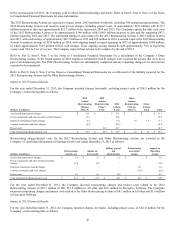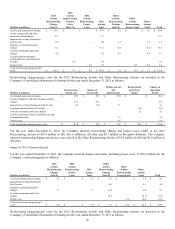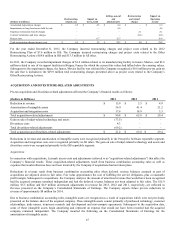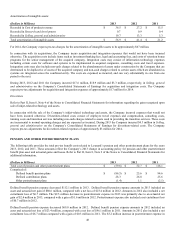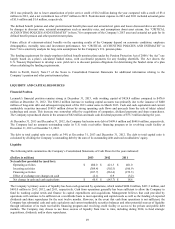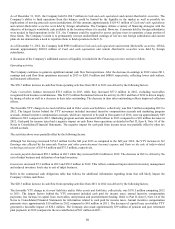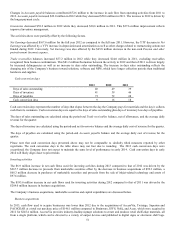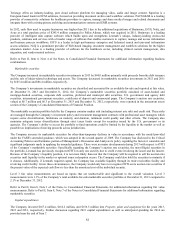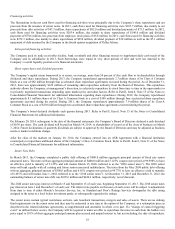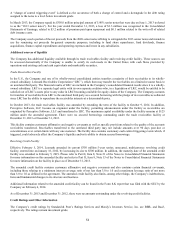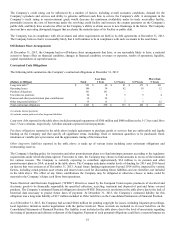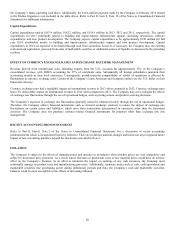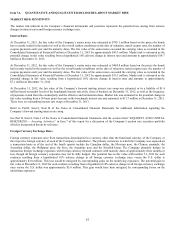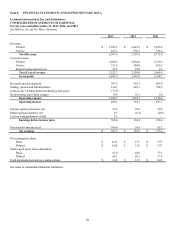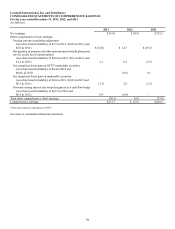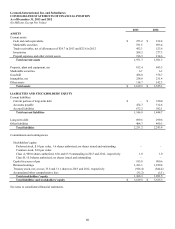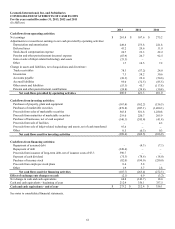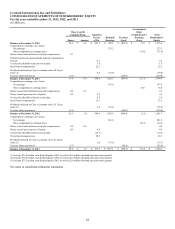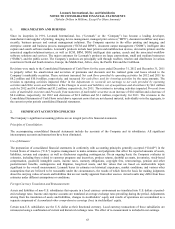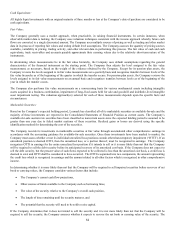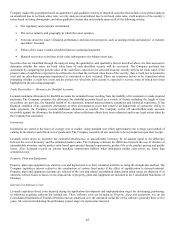Lexmark 2013 Annual Report Download - page 59
Download and view the complete annual report
Please find page 59 of the 2013 Lexmark annual report below. You can navigate through the pages in the report by either clicking on the pages listed below, or by using the keyword search tool below to find specific information within the annual report.
The Company’s credit rating can be influenced by a number of factors, including overall economic conditions, demand for the
Company’s products and services and ability to generate sufficient cash flow to service the Company’s debt. A downgrade in the
Company’s credit rating to non-investment grade would decrease the maximum availability under its trade receivables facility,
potentially increase the cost of borrowing under the revolving credit facility and increase the coupon payments on the Company’s
public debt, and likely have an adverse effect on the Company’s ability to obtain access to new financings in the future. The Company
does not have any rating downgrade triggers that accelerate the maturity dates of its Facility or public debt.
The Company was in compliance with all covenants and other requirements set forth in its debt agreements at December 31, 2013.
The Company believes that it is reasonably likely that it will continue to be in compliance with such covenants in the near future.
Off-Balance Sheet Arrangements
At December 31, 2013, the Company had no off-balance sheet arrangements that have, or are reasonably likely to have, a material
current or future effect on financial condition, changes in financial condition, revenues or expenses, results of operations, liquidity,
capital expenditures or capital resources.
Contractual Cash Obligations
The following table summarizes the Company’s contractual obligations at December 31, 2013:
(Dollars in Millions) Total
Less than
1
Year 1-3 Years 3-5 Years
More than
5
Years
Long-term debt (1) $ 923 $ 40 $ 81 $ 371 $ 431
Operating leases 106 34 42 18 12
Purchase obligations 141 141 – – –
Uncertain tax positions 24 8 3 9 4
Pension and other postretirement plan contributions 34 34 – – –
Other long-term liabilities (2) 35 13 7 3 12
Total contractual obligations $ 1,263 $ 270 $ 133 $ 401 $ 459
(1) includes interest payments
(2) includes current portion of other long-term liabilities
Long-term debt reported in the table above includes principal repayments of $300 million and $400 million in the 3-5 Years and More
than 5 Years columns, respectively. All other amounts represent interest payments.
Purchase obligations reported in the table above include agreements to purchase goods or services that are enforceable and legally
binding on the Company and that specify all significant terms, including: fixed or minimum quantities to be purchased; fixed,
minimum or variable price provisions; and the approximate timing of the transaction.
Other long-term liabilities reported in the table above is made up of various items including asset retirement obligations and
restructuring reserves.
The Company’s funding policy for its pension and other postretirement plans is to fund minimum amounts according to the regulatory
requirements under which the plans operate. From time to time, the Company may choose to fund amounts in excess of the minimum
for various reasons. The Company is currently expecting to contribute approximately $34 million to its pension and other
postretirement plans in 2014, as noted in the table above. The Company anticipates similar levels of funding for 2015 and 2016 based
on factors that were present as of December 31, 2013. Actual future funding requirements beyond 2014 will be impacted by various
factors, including actual pension asset returns and interest rates used for discounting future liabilities and are, therefore, not included
in the table above. The effect of any future contributions the Company may be obligated or otherwise choose to make could be
material to the Company’s future cash flows from operations.
Waste Electrical and Electronic Equipment (“WEEE”) Directives issued by the European Union require producers of electrical and
electronic goods to be financially responsible for specified collection, recycling, treatment and disposal of past and future covered
products. The Company’s estimated financial obligation related to WEEE Directives is not shown in the table above due to the lack of
historical data necessary to project future dates of payment. At December 31, 2013, the Company’s estimated liability for this
obligation was a long-term liability of $2.7 million included in Other liabilities on the Consolidated Statements of Financial Position.
As of December 31, 2013, the Company had accrued $64.0 million for pending copyright fee issues, including litigation proceedings,
local legislative initiatives and/or negotiations with the parties involved. These accruals are included in Accrued liabilities on the
Consolidated Statements of Financial Position. The liability is not included in the table above due to the level of uncertainty regarding
the timing of payments and ultimate settlement of the litigation. Payment of such potential obligations could have a material impact on
55


